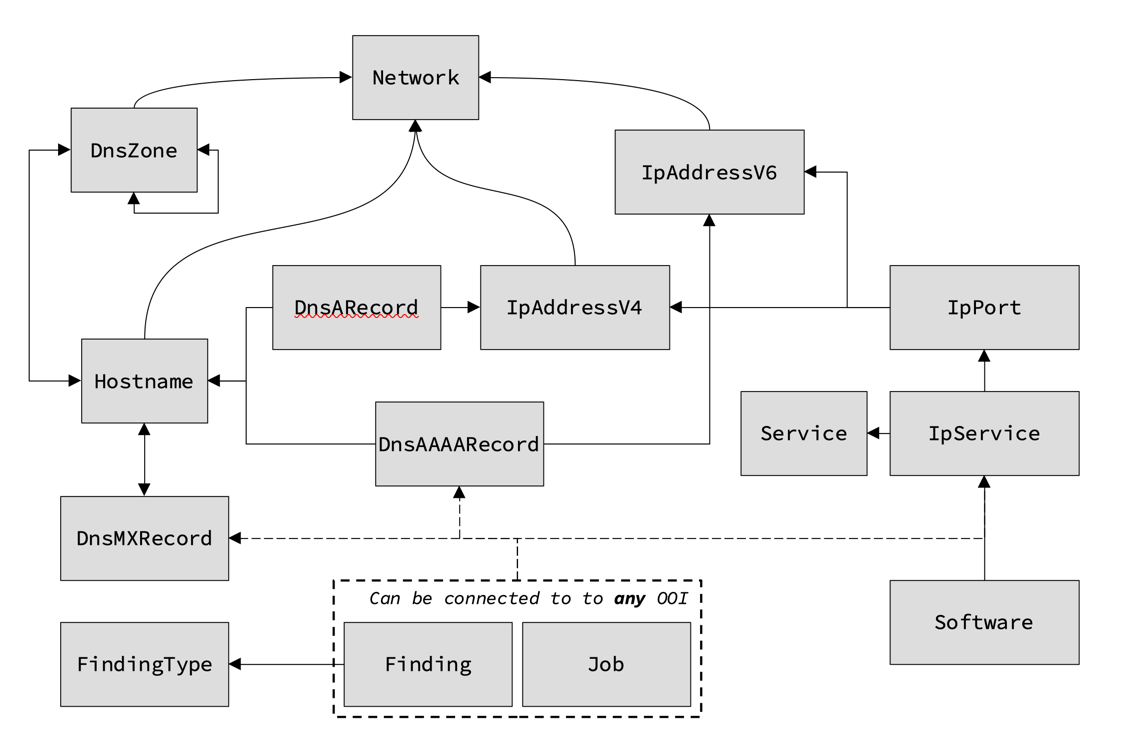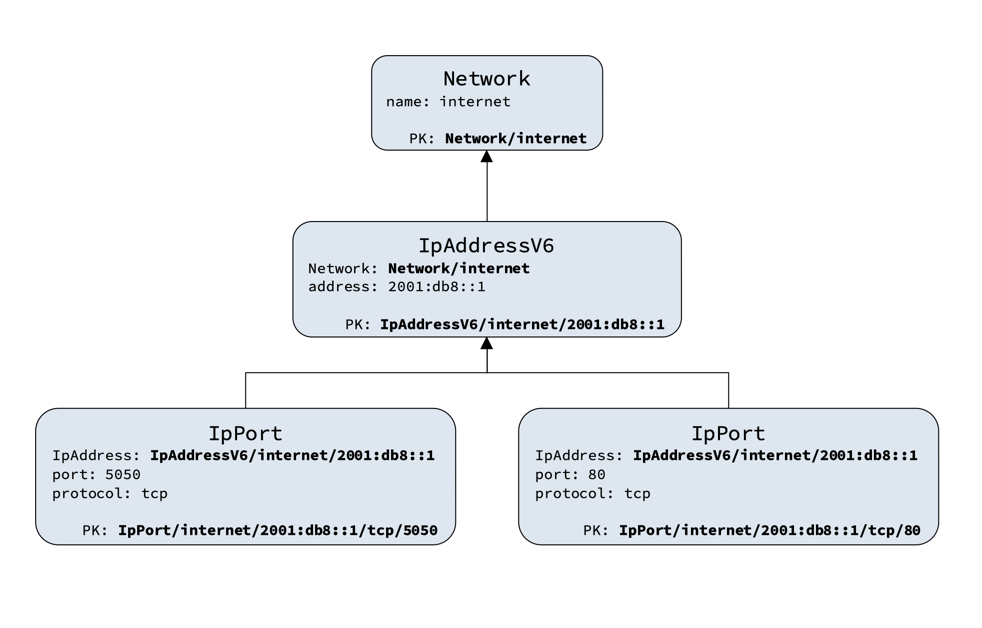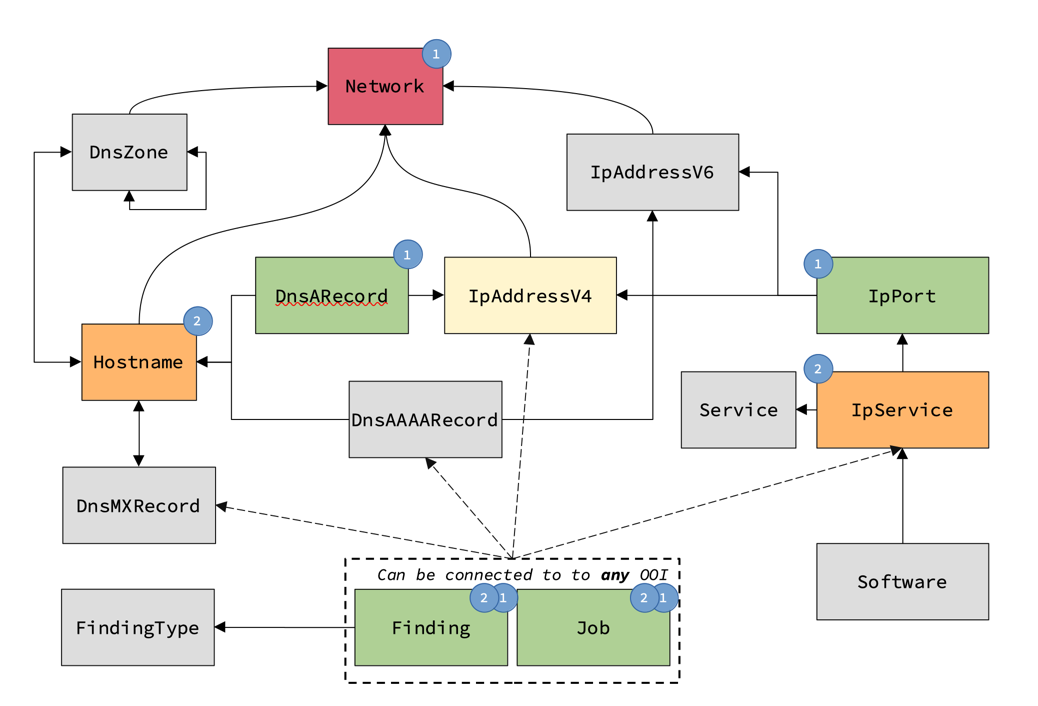Octopoes
Octopoes is KAT’s knowledge-graph. It stores the knowledge KAT has gathered about its domain. As Octopoes uses XTDB for bi-temporal data-storage, Octopoes keeps the current state of the knowledge-graph, as well as a complete, queryable history of the knowledge-graph.
Instructions
Install dependencies
python3 -m pip install -r requirements.txt
Run Octopoes API
python3 -m uvicorn octopoes.api.api:app [--port 8000]
Run the event processor
python3 -m celery -A octopoes.tasks.tasks worker -B -s /tmp/celerybeat-schedule --loglevel=WARNING
Note: The -B flag instructs celery start the Celery Beat scheduler in the same process
Note: The -s flag is used to specify the beat schedule location and should be writeable by the user the process runs in
Healthcheck
# Return XTDB connection info
curl http://localhost:8000/_dev/health
# Return some XTDB objects (or empty list [])
curl http://localhost:8000/_dev/objects
# To request data for a different KAT-client:
curl http://localhost:8000/clientx/healthcheck
OOI
The domain of discourse, on which Octopoes operates, is described by the OOI datamodel. The OOI (Object of Interest) model is described by entities and relations between them. The OOI model is currently defined in Octopoes itself (module octopoes.model.ooi). However, it is planned to be defined in the Openkat schema registries, decoupling the applicable domain from the logic.
Origin
Each OOI must have an origin to exist in the knowledge-graph. Origins can be supplied to Octopoes in 3 ways:
origin through declaration
origin through observation
origin through inference
Each origin consists of:
the identifier of the origin-method
a source OOI
a set of result OOIs
additional metadata. E.g. the task-ID that made the observation
Origin through declaration
An OOI is declared to exist by a user of KAT.
In this case, OOI B is both source and result
flowchart RL
D[Declaration D]
subgraph result[ ]
B[OOI B]
end
B-.source.-D
D-.result.- result
Origin through observation
An observation is reported by a normalizer
An observation has a key that identifies the normalizer
An observation always has a source OOI
An observation always has a (possibly empty) set of result OOIs
flowchart LR
A[OOI A]
O["Observation O (OOI A)"]
subgraph outp[ ]
B[OOI B]
C[OOI C]
end
A-.source.-O
O-.result.- outp
Origin through inference
An object is inferred from other objects in the knowledge-graph. This is achieved by rules, declared in bits. A bit is a rule that is applied to a pattern in the knowledge-graph.
flowchart TD
subgraph pattern[ ]
direction TB
A[OOI A]---B[OOI B]
A---C[OOI C]
end
subgraph result[ ]
direction RL
D[OOI D]---E[OOI E]
end
BIT["Bit B (OOI A)"]
A-.source.-BIT
pattern-.pattern.-BIT
BIT-.result.- result
Graph mutations
Mutations can only be made by supplying an origin to Octopoes. This can be an origin through declaration, or origin through observation. When, after an origin-update, an OOI is no longer referenced by any origin. The OOI will be deleted from the knowledge-graph.
Example: observation O has result B and C
flowchart LR
A[OOI A]
A-.source.-O
O["Observation O (OOI A)"]
O-.result.- result
subgraph result[ ]
direction LR
B[OOI B]---C[OOI C]
end
After a mutation, observation O has result B. C is no longer referenced, and is deleted from the knowledge-graph.
flowchart LR
A[OOI A]
O["Observation O (OOI A)"]
subgraph result[ ]
direction LR
B[OOI B]
end
C[OOI C]:::someclass
A-.source.-O
O-.result.- result
B[OOI B]x--xC[OOI C]
classDef someclass fill:#f96, color:#000, stroke:#000;
If C had been referenced by another origin, it would not have been deleted.
OOI C is not deleted, since it’s still referenced by Observation P
flowchart LR
A[OOI A]
O["Observation O (OOI A)"]
subgraph result[ ]
direction LR
B[OOI B]
end
C2[OOI C]
A-.source.-O
O-.result.- result
B[OOI B]x--xC2
E[OOI E]
P["Observation P (OOI B)"]
subgraph result2[ ]
direction LR
D[OOI D]---C[OOI C]
end
E-.source.-P
P-.result.- result2
Code Architecture
In high level, the code architecture is as follows:
Origin gets reported to the API
API calls the service layer
Service layer calls the data layer
Data layer sends out a mutation event
Listener catches the mutation event
Listener calls service layer to process mutation
flowchart LR
Listener
API
OctopoesService
API --> OctopoesService
Listener --> OctopoesService
OctopoesService --> Repository
Repository --> XTDB[(XTDB)]
Repository --> EventManager
EventManager --> Listener
Sequence: save_origin
sequenceDiagram
actor Client
participant API
participant OctopoesService
participant OriginRepository
participant OOIRepository
participant XTDB
participant EventManager
Client ->>+ API: save_origin(origin, oois, valid_time, organisation)
API ->>+ OctopoesService: save_origin(origin, oois, valid_time)
OctopoesService ->>+ OriginRepository: save(origin, valid_time)
OriginRepository ->> XTDB: get(origin, valid_time)
OriginRepository ->> OriginRepository: compare(origin)
OriginRepository ->> XTDB: save(origin, valid_time)
OriginRepository ->> EventManager: publish( CREATE_ORIGIN )
OriginRepository ->- OctopoesService: #nbsp
OctopoesService ->>+ OOIRepository: save(ooi, valid_time)
OOIRepository ->> XTDB: get(ooi, valid_time)
OOIRepository ->> OOIRepository: compare(ooi)
OOIRepository ->> XTDB: save(ooi, valid_time)
OOIRepository ->> EventManager: publish( UPDATE_OOI )
OOIRepository ->- OctopoesService: #nbsp
OctopoesService ->- API: #nbsp
API ->- Client: #nbsp
Sequence: process update ooi
sequenceDiagram
actor EventManager
participant Listener
participant OctopoesService
participant OriginRepository
participant XTDB
EventManager ->>+ Listener: handle_event(event<UPDATE_OOI>)
Listener ->> OctopoesService: handle_update_ooi(event, valid_time)
OctopoesService ->> OriginRepository: get_origin(event.origin, type=inference)
OriginRepository ->> OctopoesService: bits
loop bits
OctopoesService ->> OctopoesService: run_bit
end
Listener ->>- EventManager: #nbsp
XTDB
XTDB is the central database of OOIs within KAT. XTDB is a graph-database that can store objects (schemalessly), while providing object history and audit-trail functionality out-of-the-box. The term bitemporal means it tracks every object on 2 time axis: valid-time and transaction-time.
Valid-time means the state of an object at a certain time X (mutable).
Transaction-time means the state of an object with all transactions-processed until time Y (immutable)
This is especially useful for forensics-type queries like: What was the state of an object at time X (valid-time), with the information we had at time Y (transaction-time).
Good to know: XTDB tracks the history of each object by its primary key.
Read more about XTDB bitemporality
XTDB-cli tool
The XTDB-cli tool is a script that can be used to query the XTDB database (v1) directly. This can be useful to query for transactions, queries, attributes, keys and more. It can be used to directly manipulate XTDB, without the interference of Octopoes. This can be useful for tasks such as experimenting, bug hunting and optimizations.
Please note: The XTDB version within OpenKAT is not the standard XTDB. It is an extended module version that adds support for multiple nodes available at: OpenKAT XTDB
The XTDB-cli tool can be found in the following folder:
https://github.com/minvws/nl-kat-coordination/tree/main/octopoes/tools
It is recommended to create a virtual environment and install the developer-requirements (in the octopoes folder) within this virtual environment. You could also execute the xtdb-cli commands from within the octopoes_api container if you are using a Dockerized setup.
The XTDB-cli tool can be queried as shown below.
From the environment:
$ ./xtdb-cli.py -h
Or from inside the container, using a new octopoes_api container instance:
$ docker compose run --rm octopoes_api tools/xtdb-cli.py -h
Usage: xtdb-cli.py [OPTIONS] COMMAND [ARGS]...
This help functionality explains how to query XTDB using the xtdb-cli tool. The help functionality for all default XTDB commands was copied from the official XTDB docs for the HTTP implementation. Not all optional parameters as available on the HTTP docs may be implemented.
Options:
-n, --node TEXT XTDB node [default: 0]
-u, --url TEXT XTDB server base url [default: http://localhost:3000]
-t, --timeout INTEGER XTDB request timeout (in ms) [default: 5000]
-v, --verbosity Increase the verbosity level [default: 0]
-h, --help Show this message and exit.
Commands:
active-queries Returns a list of currently running queries.
attribute-stats Returns frequencies of indexed attributes
await-tx Waits until the node has indexed a transaction that is at or past the supplied tx-id.
await-tx-time Blocks until the node has indexed a transaction that is past the supplied tx-time.
entity Returns the document map for a particular entity.
entity-tx Returns the transaction details for an entity - returns a map containing the tx-id and...
history Returns the history of a particular entity.
latest-completed-tx Returns the latest transaction to have been indexed by this node.
latest-submitted-tx Returns the latest transaction to have been submitted to this cluster.
list-keys List all keys in node
list-values List all values in node
query EDN Query (default: "{:query {:find [ ?var ] :where [[?var :xt/id]]}}")
recent-queries Returns a list of recently completed/failed queries.
slowest-queries Returns a list of slowest completed/failed queries ran on the node.
status Returns the current status information of the node
submit-tx Takes a vector of transactions (any combination of put, delete, match, evict and fn) and...
sync Wait until the consumer’s lag is back to 0 (i.e.
tx-committed Checks if a submitted tx was successfully committed, returning a map with tx-committed and...
tx-log Returns a list of all transactions, from oldest to newest transaction time - optionally...
txs Show all document transactions
The help file for the commands can be queried as shown below.
$ ./xtdb-cli.py history -h
Usage: xtdb-cli.py history [OPTIONS] KEY
Returns the history of a particular entity.
Options:
--with-docs Includes the documents in the response sequence, under the doc key (boolean, default: false)
--with-corrections Includes bitemporal corrections in the response, inline, sorted by valid-time then tx-id
(boolean, default: false)
-h, --help Show this message and exit.
The output below gives an example for querying the XTDB database for an organisation called ‘MyOrganisationName’. This is the organisation code, not the organisation name and can be found in the organisation overview at: http://127.0.0.1:8000/en/organizations/ listed in the code column.
$ ./xtdb-cli.py -n MyOrganisationName attribute-stats |jq .
{
"DNSSOARecord/serial": 14,
"Website/ip_service": 10,
"HTTPResource/website": 10,
"Hostname/primary_key": 8,
"DNSNSRecord/name_server_hostname": 3,
"DNSSOARecord/hostname": 14,
"HostnameHTTPURL/primary_key": 2,
"DNSTXTRecord/dns_record_type": 2,
"TLSCipher/ip_service": 4,
"DNSMXRecord/value":
....
}
Examples
In these examples we supply the Dockerized calls, expecting the server to be available on localhost:3000 and we use an organization or node that’s called ‘test’
# list all network OOIs
$ docker compose run --rm octopoes_api tools/xtdb-cli.py --url http://crux:3000 --node test query '{:query {:find [ ?var ] :where [[?var :object_type "Network"]]}}'
# list all IPAddressV4 objects
$ docker compose run --rm octopoes_api tools/xtdb-cli.py --url http://crux:3000 --node test query '{:query {:find [ ?var ] :where [[?var :object_type "IPAddressV4"]]}}'
# show the transaction (or TxId's and their timestamps) of a single OOI (A findingType in this case)
$ docker compose run --rm octopoes_api tools/xtdb-cli.py --url http://crux:3000 --node test history 'KATFindingType|KAT-WEBSERVER-NO-IPV6'
# show the Contents of a single OOI (A FindingType in this case)
$ docker compose run --rm octopoes_api tools/xtdb-cli.py --url http://crux:3000 --node test entity 'KATFindingType|KAT-WEBSERVER-NO-IPV6'
# the same, but now return the most recent) metadata for that object
$ docker compose run --rm octopoes_api tools/xtdb-cli.py --url http://crux:3000 --node test entity-tx 'KATFindingType|KAT-WEBSERVER-NO-IPV6'
XTDB analyze bits tool
This guide assumes the following:
A virtual environment for the octopoes folder is created and the development requirements are installed.
This tooling can be used when you are developing bits (business rules). It outputs the transaction times in the database, the source and bit information, including parameters and how long the running time was.
Enable the GATHER_BIT_METRICS setting in the following file. The flag is at the bottom of the file. Change GATHER_BIT_METRICS=False to GATHER_BIT_METRICS=True.
octopoes/octopoes/config/settings.py
Run a make reset in your KAT instance to enable the setting:
make reset
Create some data by adding a hostname, enable some boefjes, etc. This will allow the bit metrics to be gathered. You can query the bit metrics using the following commands. The node is the name of your organisation. In this example the organisation name is ‘aa’.
python3 octopoes/tools/analyze-bit-metric.py --node "aa" raw |jq
python3 octopoes/tools/xtdb-cli.py -n "aa" history --with-docs "BIT_METRIC" |jq
If you want to query the XTDB database directly, you can use the XTDB-tool. This is explained on the following page: https://docs.openkat.nl/developer_documentation/octopoes.html#xtdb-cli-tool.
OOI Objects
OOI objects are instances of relatively simple classes, which inherit from OOI.
Because all OOIs are stored in XTDB and XTDB tracks object history by primary key, KAT defines a way to reliably determine the primary key of an object by its attributes. This is called the natural key of an object.
The main advantage of this method, is that when enough attributes of an OOI are discovered, the primary key of this object is known. This allows reasoning about the exact same objects in several subsystems, without having to query a database.
Consider this (oversimplified) Person class
from octopoes.models import OOI
class Person(OOI):
name: str
last_name: str
age: int
_natural_key_attributes: ['name', 'last_name']
# 2 completely separate systems can instantiate the the following Person OOI:
john = Person(name='John', last_name='Doe', age=42)
# And without having to search this person in a central database, the primary key is known:
john.natural_key # 'John/Doe'
john.primary_key # 'Person/John/Doe'
Note that the primary key consists of the natural key prefixed by the OOI-type, to avoid PK collisions
Relationships
OOIs can be related to each other. At time of writing the OOI data structure looks like this:
Directional arrows indicate a foreign key pointing to referred object

In a one-to-many relationship (A 1-* B), the relationship is stored in B (B points to A). For example, an IP-address belongs to a Network. So the Network primary key is stored as a foreign key in the IP-address object.
from octopoes.models import OOI, Reference
class Network(OOI):
name: str
_natural_key_attrs = ['name']
class IpAddressV6(OOI):
Network: Reference[Network]
address: str
_natural_key_attrs = ['Network', 'address']
A few example records

OOI Reference
Even though foreign keys are actually simple strings, for ease of use these strings are represented in Octopoes by a special Reference object.
OOIRefs can be obtained in several ways.
from octopoes.models import Reference
from octopoes.models.ooi.network import Network, IPAddressV6
# Through the .ref() method of an OOI instance
internet = Network(name='internet')
internet_ref = internet.reference
# Or from string
internet_ref = Reference.from_str('Network|internet')
# Create a related object with a ref
ip = IPAddressV6(network=internet_ref, address='2001:db8::1')
Since an OOIRef is a compound key, individual parts of the foreign key can be retrieved by the parsed property.
from octopoes.models import Reference
ref = Reference.from_str('IpPort|internet|2001:db8::1|tcp|5050')
ref.tokenized.protocol # 'tcp'
ref.tokenized.port # '5050'
ref.tokenized.address.address # '2001:db8::1'

Octopoes API
OctopoesAPIConnector
The OctopoesAPIConnector class provides a Python interface for connecting with Octopoes API. It provides several methods for doing CRUD operations for the objects/entities.
Querying objects
In particular, for querying objects we have:
OctopoesAPIConnector.list_objects()to filter on OOIstype,scan_level,scan_profile_typeandvalid_time.
This is used for example in the object overview page. Returns a paginated list of OOIs.
OctopoesAPIConnector.get_tree()to filter out neighbouring OOIs starting from a root OOI (reference) in the object graph.
The graph is traversed until a specified depth is reached, filtering on types and valid_time.
Returns a ReferenceTree: a tree-like structure of OOIs representing a subgraph of the objects graph.
The conversion from graph to tree happens through “unfolding” the graph during traversal and allowing duplication of
nodes in the tree to avoid cycles. Because of the duplication the structure includes a unique, flattened list of OOIs
present in the tree, the ReferenceTree.store, for convenience. Unsurprisingly, this method is used for rendering
object-graphs.
OctopoesAPIConnector.list_origins()to filter onvalid_time,source,result,task_idandorigin_type.
Due to the task_id filter, this allows users to connect OOIs to the most recent normalizer task
that found these OOIs. This is used to find the original boefje task and raw data that “proofs” the existence of the
OOIs. Returns a list of Origins.
OctopoesAPIConnector.list_findings()to filter Findings onvalid_time,severities,exclude_muted,only_muted,offset,limit.
This method offers some Finding-specific filters for convenience on Finding pages. Returns a paginated list of Findings.
Abstract classes / subclassing
Relationships from an OOI class to another OOI class are inferred through its property types. It is possible to define a relationship to an abstract class.
For querying purposes and grouping purposes these abstract classes can also be used.
from octopoes.models import OOI, Reference
from octopoes.connector.octopoes import OctopoesAPIConnector
# Define abstract class and subclasses
class IPAddress(OOI):
...
class IPAddressV4(IPAddress):
...
class IPAddressV6(IPAddress):
...
# Relationships to abstract class
class IPPort(OOI):
address: Reference[IPAddress] # Any subclass of IPAddress (IPAddressV4, IPAddressV6)
protocol: str
port: int
class TagExample(OOI):
ooi: Reference[OOI] # Any subclass of OOI..
tag: str
# Query abstract class
OctopoesAPIConnector('http://octopoes', '_dev').list_objects({IPAddress})
Querying
Octopoes API uses the OOI model to construct XTDB queries. For complex graph-querying, XTDB’s pull-syntax is used to build a query tree. XTDB can join objects to properties which hold (lists of) foreign keys.
Imagine a query “Give me IpAddressV4 with primary key X and all related objects 2 levels deep”.
What happens under the hood:
A relation map is created with all OOI classes and their relations
A query plan is created by traversing the relation map 2 levels deep. The queryplan is a tree of QueryNode objects
The query plan is transformed into a XTDB Datalog query, utilizing its pull syntax to join related objects
Rules: A few rules come into play when planning the query.
Relations are not traversed back through the previous relation. E.g.:
IpAddressV4 -> IpPort -> IpAddressV4Leaf nodes are OOI classes that have too many relations to effectively traverse if they are not the starting node. Currently these are
Network,FindingandJob
Query Plan Visualization: The OOI class tree is traversed 2 levels deep. Bear in mind that both Finding and Job can be related to any OOI, so the following paths are valid:
- IpAddressV4 -> Finding
- IpAddressV4 -> Job
- IpAddressV4 -> DnsARecord -> Finding
- IpAddressV4 -> DnsARecord -> Job
- IpAddressV4 -> IpPort -> Finding
- IpAddressV4 -> IpPort -> Job
- IpAddressV4 -> IpPort -> IpService
- IpAddressV4 -> DnsARecord -> Hostname
....etc
Hence the 1 and 2 levels markers on Finding and Job in the image below.

Run bit manually
It is possible to manually run a bit using
$ ./tools/run_bit.py ORGANIZATION_CODE BIT_ID OOI
This will execute the bit with debug logging turned on. run_bit.py supports
the --pdb option to enter the standard Python Debugger when an exceptions
happens or breakpoint is triggered.
If you are using the standard docker compose developer setup, you can use
docker compose exec to execute the command in the container:
$ docker compose exec octopoes_api ./tools/run_bit.py ORGANIZATION_CODE BIT_ID OOI
Example usage:
$ docker compose exec octopoes_api ./tools/run_bit.py comp dns-resolving "DNSARecord|internet|mispo.es|314.15.926.53."
Tests
The unit tests octopoes/tests are run using
python -m unittest discover octopoes/tests